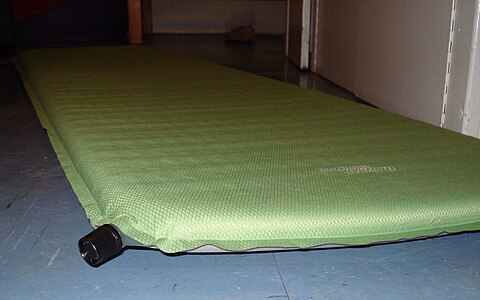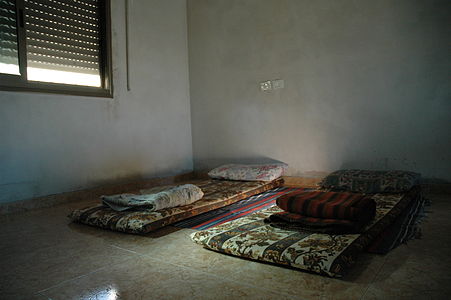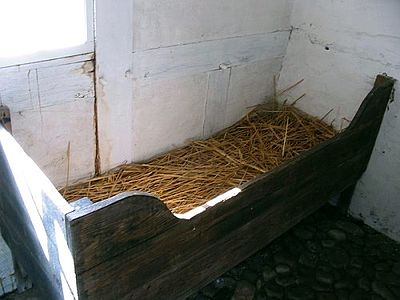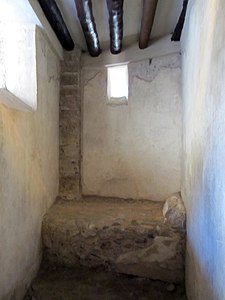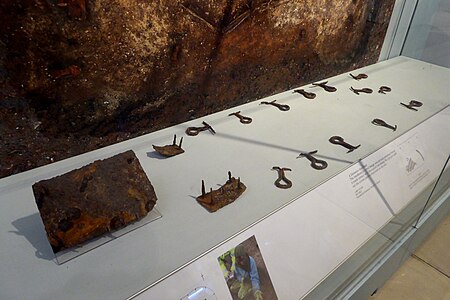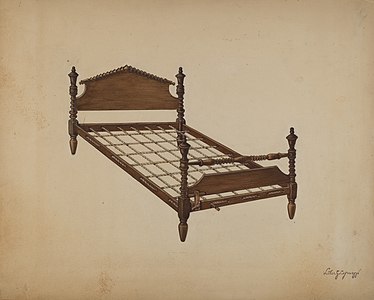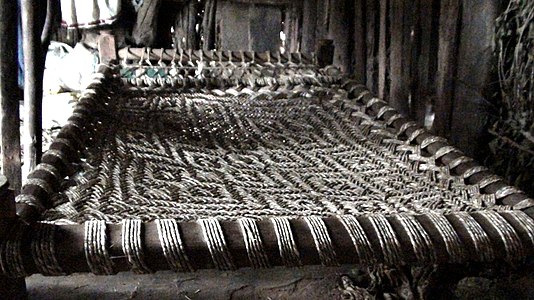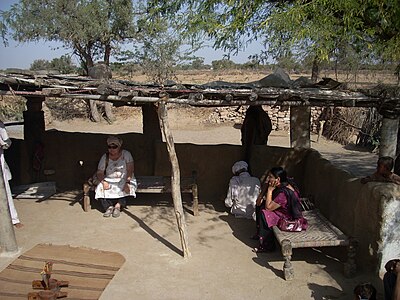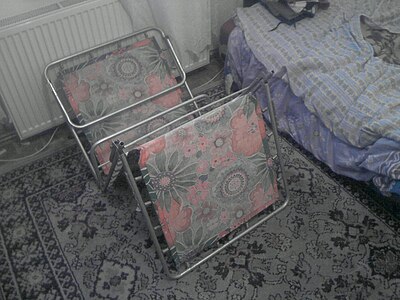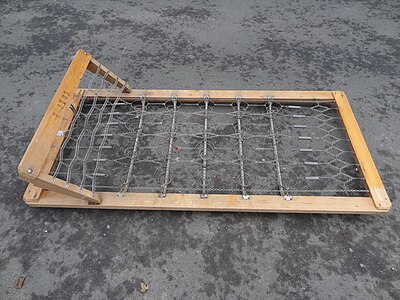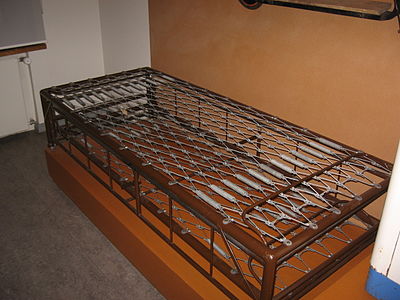
A hammock, from Spanish hamaca, borrowed from Taíno and Arawak hamaka, is a sling made of fabric, rope, or netting, suspended between two or more points, used for swinging, sleeping, or resting. It normally consists of one or more cloth panels, or a woven network of twine or thin rope stretched with ropes between two firm anchor points such as trees or posts. Hammocks were developed by native inhabitants of the Americas for sleeping, as well as the English. Later, they were used aboard ships by sailors to enable comfort and maximize available space, by explorers or soldiers travelling in wooded regions and eventually by parents in the early 1920s for containing babies just learning to crawl. Today they are popular around the world for relaxation; they are also used as a lightweight bed on camping trips. The hammock is often seen as a symbol of summer, leisure, relaxation and simple, easy living.

A futon is a traditional Japanese style of bedding.

An air mattress is an inflatable mattress or sleeping pad.

A bedroom or bedchamber is a room situated within a residential or accommodation unit characterised by its usage for sleeping. A typical western bedroom contains as bedroom furniture one or two beds, a clothes closet, and bedside table and dressing table, both of which usually contain drawers. Except in bungalows, ranch style homes, ground floor apartments, or one-storey motels, bedrooms are usually on one of the floors of a dwelling that is above ground level. Beds range from a crib for an infant; a single or twin bed for a toddler, child, teenager or single adult; to bigger sizes like a full, double, queen, king or California king). Beds and bedrooms are often devised to create barriers to insects and vermin, especially mosquitoes, and to dampen or contain light or noise to aid sleep and privacy.

A mattress is a large, usually rectangular pad for supporting a lying person. It is designed to be used as a bed, or on a bed frame as part of a bed. Mattresses may consist of a quilted or similarly fastened case, usually of heavy cloth, containing materials such as hair, straw, cotton, foam rubber, or a framework of metal springs. Mattresses may also be filled with air or water.

Bedding, also called bedclothes or bed linen, is the materials laid above the mattress of a bed for hygiene, warmth, protection of the mattress, and decorative effect. Bedding is the removable and washable portion of a human sleeping environment. Multiple sets of bedding for each bed are often washed in rotation and/or changed seasonally to improve sleep comfort at varying room temperatures. Most standardized measurements for bedding are rectangular, but there are also some square-shaped sizes, which allows the user to put on bedding without having to consider its lengthwise orientation.

A bed is an item of furniture that is used as a place to sleep, rest, and relax.

Charpai is a traditional woven bed used across South Asia. The name charpai is a compound of char “four” and pay “footed”. Regional variations are found in Afghanistan and Pakistan, North and Central India, Bihar and Myanmar.
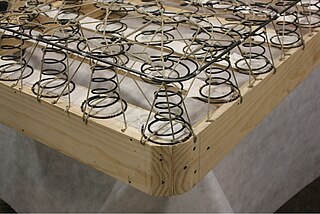
A box-spring is a type of bed base typically consisting of a sturdy wooden frame covered in cloth and containing springs. Usually the box-spring is placed on top of a wooden or metal bedframe that sits on the floor and acts as a brace, except in the UK where the divan is more often fitted with small casters. The box-spring is usually the same size as the much softer mattress that is placed on it. Working together, the box-spring and mattress make up a bed. It is common to find a box-spring and mattress being used together without the support of a frame underneath, the box spring being mounted directly on casters standing on the floor.

A sofa bed or sofa-bed is a multifunctional furniture typically consisting of a sofa or couch that, underneath its seating cushions, hides a metal frame and thin mattress that can be unfolded or opened up to make a bed. A western-style futon differs from a sofa bed, although sofa beds using futon mattresses are common.

Straw plaiting is a method of manufacturing textiles by braiding straw and the industry that surrounds the craft of producing these straw manufactures. Straw is plaited to produce products including straw hats and ornaments, and the process is undertaken in a number of locations worldwide.

A bed frame or bedstead is the part of a bed used to position the bed base, the flat part which in turn directly supports the mattress(es). The frame may also stop the mattress from sliding sideways, and it may include means of supporting a canopy above. There are several types of Bed Frames found around the globe. They are typically made of wood or metal. A bed frame includes head, foot, and side rails. The majority of double (full) beds and all queen- and king-sized beds necessitate a central support rail, often accompanied by additional feet that extend towards the floor for stability. The concept of a "bed frame" was initially introduced and referred to between 1805 and 1815. This foundational support system not only reinforces the structure of the bed but also ensures its durability and longevity, distributing weight evenly to prevent sagging and enhance overall comfort. Not all beds include frames: see bed base.

A daybed is an item of furniture used as a bed as well as for lounging, reclining, and seating in a common room. It may be considered a form of multifunctional furniture. Their frames can be made out of wood, metal or a combination of wood and metal. They are a cross between a chaise longue, a couch, and a bed.
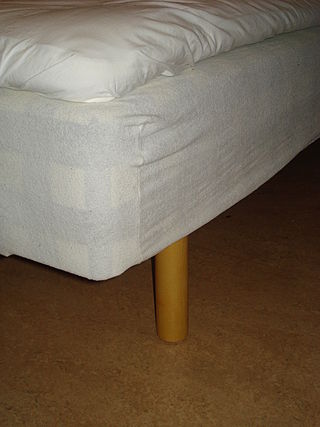
A mattress protector is an item of removable bedding that sits on top of, or encases, a mattress to protect it. Some mattress protectors also provide protection to the person sleeping on the mattress from allergens and irritants such as dust mites, bed bugs, mold, and dead skin.
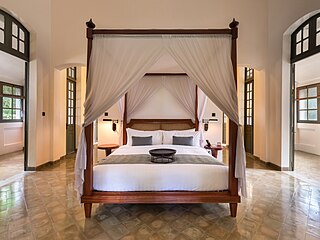
A canopy bed is a bed with a canopy, which is usually hung with bed curtains. Functionally, the canopy and curtains keep the bed warmer, and screen it from light and sight. On more expensive beds, they may also be elaborately ornamental.

A mattress pad, mattress topper, or underpad is designed to lie atop a mattress. Made from a variety of materials including wool, cotton, memory foam, feather and latex, its function is to provide an extra layer of comfort, especially when the existing mattress is worn or uncomfortable.

Ancient furniture was made from many different materials, including reeds, wood, stone, metals, straws, and ivory. It could also be decorated in many different ways. Sometimes furniture would be covered with upholstery, upholstery being padding, springs, webbing, and leather. Features which would mark the top of furniture, called finials, were common. To decorate furniture, contrasting pieces would be inserted into depressions in the furniture. This practice is called inlaying.
Shifman Mattress Company is a manufacturer and distributor of handcrafted sleeping mattresses. The mattresses are made using hand-tufting techniques, eight-way hand-tied boxsprings and natural materials. In addition, Shifman Mattresses are two-sided. The company's headquarters are located in Newark, New Jersey.

A tick mattress, bed tick or tick is a large bag made of strong, stiff, tightly-woven material (ticking). This is then filled to make a mattress, with material such as straw, chaff, horsehair, coarse wool or down feathers, and less commonly, leaves, grass, reeds, bracken, or seaweed. The whole stuffed mattress may also, more loosely, be called a tick. The tick mattress may then be sewn through to hold the filling in place, or the unsecured filling could be shaken and smoothed as the beds were aired each morning. A straw-filled bed tick is called a paillasse, palliasse, or pallet, and these terms may also be used for bed ticks with other fillings. A tick filled with flock is called a flockbed. A feather-filled tick is called a featherbed, and a down-filled one a downbed; these can also be used above the sleeper, as a duvet.
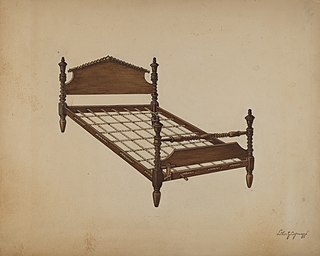
A rope bed is a type of platform bed in which the sleeper is supported by a lattice of rope, rather than wooden slats.


